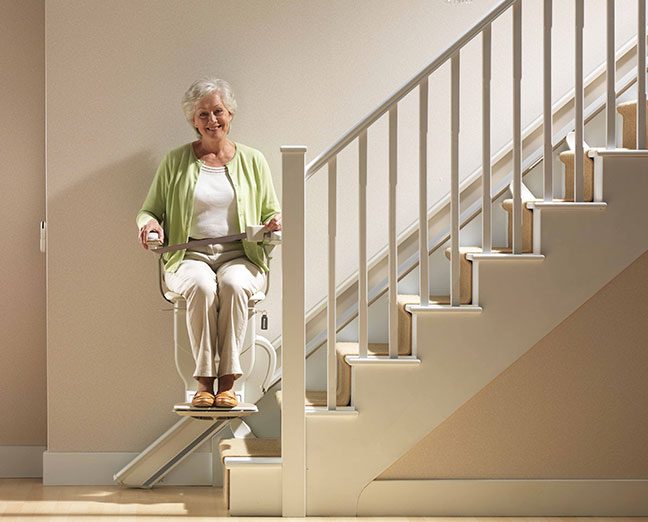If you live in a small home or have a narrow staircase, you might assume that installing a stairlift simply isn’t possible. The good news? Modern stairlift designs have come a long way — and today’s models can fit safely and comfortably in even the tightest of spaces. With the right planning and professional guidance, a stairlift can make your home safer and more accessible without major renovations.
In this guide, we’ll walk you through how to fit a stairlift in a small or narrow staircase, what to consider before installation, and how to find the best solution for your home.
Understanding the Challenges of Small Staircases
Small or narrow staircases are common in UK homes, especially in older properties and terraced houses. These stairs often have:
- Limited width (typically under 70cm)
- Tight corners or turns
- Obstructions like radiators, doors, or low ceilings
- Uneven steps or unique designs
These features can make fitting a standard stairlift tricky — but not impossible. The key is choosing the right model and configuration to match your staircase layout.
Step 1: Measure Your Staircase Accurately
Before you can choose a stairlift, you’ll need precise measurements of your staircase. A professional surveyor will typically measure:
- The width of the staircase
- The length and angle of the stairs
- The clearance at the top and bottom of the staircase
- Any obstacles that could affect installation
As a general rule, most stairlifts require a minimum staircase width of about 66cm (26 inches). However, some ultra-slim models are designed to work in spaces as narrow as 60cm, making them ideal for compact homes.
Step 2: Choose the Right Stairlift Type
Not all stairlifts are created equal. The type of staircase you have — straight or curved — will determine the best lift option.
Straight Stairlifts
If your staircase runs in a single, straight line, a straight stairlift is the most affordable and straightforward option. Many models come with folding seats, arms, and footrests, allowing the stairlift to tuck neatly away when not in use.
Curved Stairlifts
If your staircase has bends, turns, or intermediate landings, a curved stairlift is the right choice. These are custom-made to fit your staircase’s exact shape. Some models feature tight-radius rails, perfect for narrow or winding stairs.
Perch or Standing Stairlifts
For extremely narrow stairs or users with limited knee flexibility, a perch stairlift can be ideal. Instead of sitting, you ride in a semi-standing position, saving space while maintaining safety and stability.
Step 3: Consider Compact or Slimline Designs
When space is limited, every inch counts. Look for stairlifts with:
- Slimline rails that hug the wall closely
- Folding components to free up space for others using the stairs
- Wall-mounted controls instead of bulky arm switches
- Battery-powered operation (avoids wiring clutter)
Today’s compact stairlifts are designed with small homes in mind, offering smooth performance and space-efficient features without compromising comfort or safety. Discover the best value stairlifts for small homes in the UK.
Step 4: Work with a Professional Installer
Even with the slimmest stairlift model, proper installation is crucial for safety and reliability. A qualified installer will:
- Conduct a full home assessment
- Recommend suitable models for your staircase size and shape
- Ensure compliance with safety standards and electrical requirements
- Provide aftercare and maintenance support
Avoid trying to install a stairlift yourself — professional fitting ensures the equipment operates safely and lasts longer.
Step 5: Plan for Comfort and Accessibility
A well-fitted stairlift should feel comfortable, safe, and easy to use. Consider:
- Seat height and padding for proper support
- Easy-to-reach controls (ideal for those with arthritis or mobility issues)
- Smooth start and stop motion to prevent jolts
- Swivel seats to help you get on and off safely at the top of the stairs
If you share the staircase with others, folding rails or seats can make everyday access easier.
Step 6: Check Local Regulations and Building Features
In most UK homes, stairlift installation doesn’t require planning permission, but it’s wise to check if you live in a listed building or shared property. Your installer can help ensure your new stairlift meets all safety and electrical standards.
You should also check the load capacity (usually between 120–140kg) to make sure it’s appropriate for your needs.
Step 7: Maintain Your Stairlift for Long-Term Safety
Once your stairlift is installed, regular maintenance will keep it running smoothly. Most providers offer annual service plans to:
- Lubricate the rail and moving parts
- Check safety sensors and batteries
- Inspect the seat and footrest for wear and tear
A well-maintained stairlift can last 10–15 years or more, providing lasting independence and peace of mind.
Final Thoughts
Even if your home has a narrow or awkward staircase, you don’t have to give up on accessibility. With today’s compact and customizable stairlift designs, you can enjoy safe, effortless mobility — no matter the size of your home.
If you’re unsure which model suits your space best, book a free home assessment with a reputable stairlift provider. They’ll help you find the perfect fit for your staircase, budget, and lifestyle — so you can stay independent and comfortable in your own home.





























